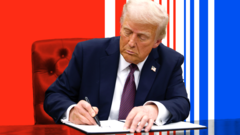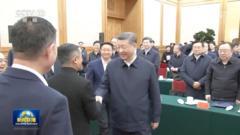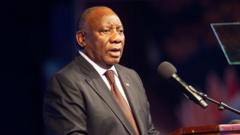The U.S. faces backlash from key trading partners as new tariffs incite fears of a trade war.
**Trade Tensions Escalate as Trump Imposes Tariffs, Prompting Global Reactions**

**Trade Tensions Escalate as Trump Imposes Tariffs, Prompting Global Reactions**
Amid rising protectionism, Canada, Mexico, and China respond to new U.S. tariffs with potential countermeasures.
The United States finds itself at the center of a developing trade conflict following a recent announcement by President Trump imposing significant tariffs on imports from Canada and Mexico. This protective measure is seen as a push towards an era of more aggressive trade practices, drawing immediate responses from both nations. Canadian Prime Minister Justin Trudeau expressed his dismay in a televised address, stating, “We don’t want to be here,” highlighting the historical ties and interdependence between the two countries.
The tariffs, which raise taxes to 25% on a wide array of goods—including honey, tomatoes, clothing, and household items—are expected to affect over $100 billion worth of trade from the U.S. to Canada. In addition, a 10% tariff is imposed on goods from China, with the Chinese government vowing to respond with “corresponding countermeasures” to protect its interests and hinting at possible actions within the World Trade Organization.
In Mexico, President Claudia Sheinbaum announced plans to implement her government’s “Plan B” on retaliatory measures, stating that further details would be revealed pending negotiations with the U.S. She warned of both tariff and non-tariff responses that could directly impact trade relations. This wave of economic tension prompts concerns among businesses and consumers alike, with warnings of price increases looming on the horizon amidst the standoff.
As both sides navigate this complex landscape, the potential for an escalating trade war grows, shaping future relationships and trade dynamics across North America and beyond.
The tariffs, which raise taxes to 25% on a wide array of goods—including honey, tomatoes, clothing, and household items—are expected to affect over $100 billion worth of trade from the U.S. to Canada. In addition, a 10% tariff is imposed on goods from China, with the Chinese government vowing to respond with “corresponding countermeasures” to protect its interests and hinting at possible actions within the World Trade Organization.
In Mexico, President Claudia Sheinbaum announced plans to implement her government’s “Plan B” on retaliatory measures, stating that further details would be revealed pending negotiations with the U.S. She warned of both tariff and non-tariff responses that could directly impact trade relations. This wave of economic tension prompts concerns among businesses and consumers alike, with warnings of price increases looming on the horizon amidst the standoff.
As both sides navigate this complex landscape, the potential for an escalating trade war grows, shaping future relationships and trade dynamics across North America and beyond.




















